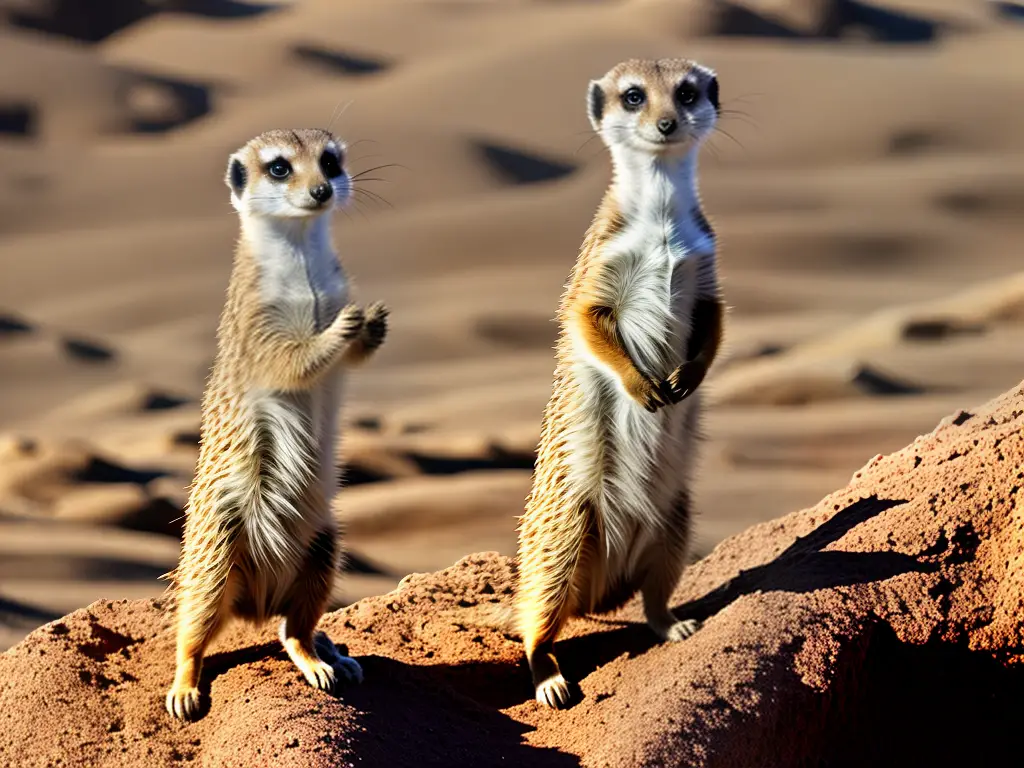Meerkat Basics
Meerkats are small, burrowing mammals that belong to the mongoose family. They are also known as ‘suricates’ and mainly live in the Kalahari Desert in southern Africa. Meerkats have slender bodies with long, thin legs and a pointy snout. Their fur is usually light brown with dark stripes across their backs, which helps them blend into their surroundings.
These curious creatures have a sociable nature and live in groups called ‘clans’, ‘gangs’ or ‘mobs’. Each group can have up to 50 members, and they work together to find food, raise their young, and keep watch for predators. Meerkats have a unique standing posture, using their hind legs and tail to support themselves while they scan the horizon for threats.
Meerkats inhabit areas with sandy soil or open plains where they can easily dig their burrows. These burrows serve as a shelter and protection against predators and extreme weather. They are experts in digging and create complex tunnel systems with multiple entrances and chambers inside the burrow for sleeping, giving birth, and escaping from danger.
Meerkats are fascinating animals that live in the wilds of Africa. They are known for their unique social structure, which helps them survive in their harsh environment. Meerkats live in groups called clans or mobs, which can have as many as 50 members. These social groups are made up of several family units, each consisting of a breeding pair and their offspring.
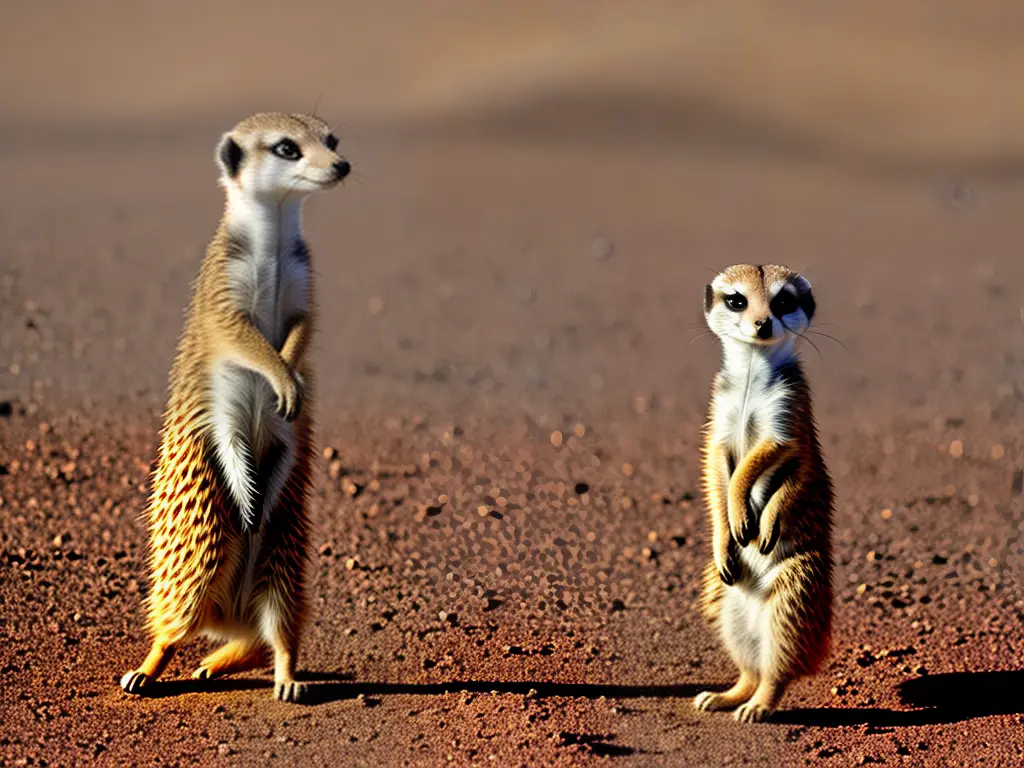
Their diet mainly consists of insects, but they also eat small animals like lizards, snakes, and scorpions. Meerkats have developed immunity to some venomous creatures, which makes it easier for them to hunt and consume their prey. They are diurnal animals, which means they are most active during the day when they forage for food and socialize with their group members.
Living in a clan provides meerkats with many benefits. They work together to find food, raise their young, and protect each other from predators. By working as a team, meerkats can accomplish tasks that would be impossible for them to do alone. One of the most interesting things about meerkats’ social structure is their system of cooperative care, where all clan members help to look after the young.
While the dominant female is busy foraging for food, the other clan members take turns babysitting and teaching the young meerkats how to survive. This system of shared responsibility ensures that the young meerkats receive the necessary care and guidance to grow up strong and healthy. Working together also provides an added layer of protection for the clan, as more individuals are available to watch for danger.
In the plains and semi-deserts of Southern Africa, Meerkats (Suricata suricatta) can be found thriving in their harsh habitat. These small creatures, which belong to the mongoose family, are well-known for their cooperative care and living in clans. Meerkats collaborate in digging and maintaining their intricate burrow systems, which provide a safe haven from predators, extreme temperatures, and other environmental challenges.
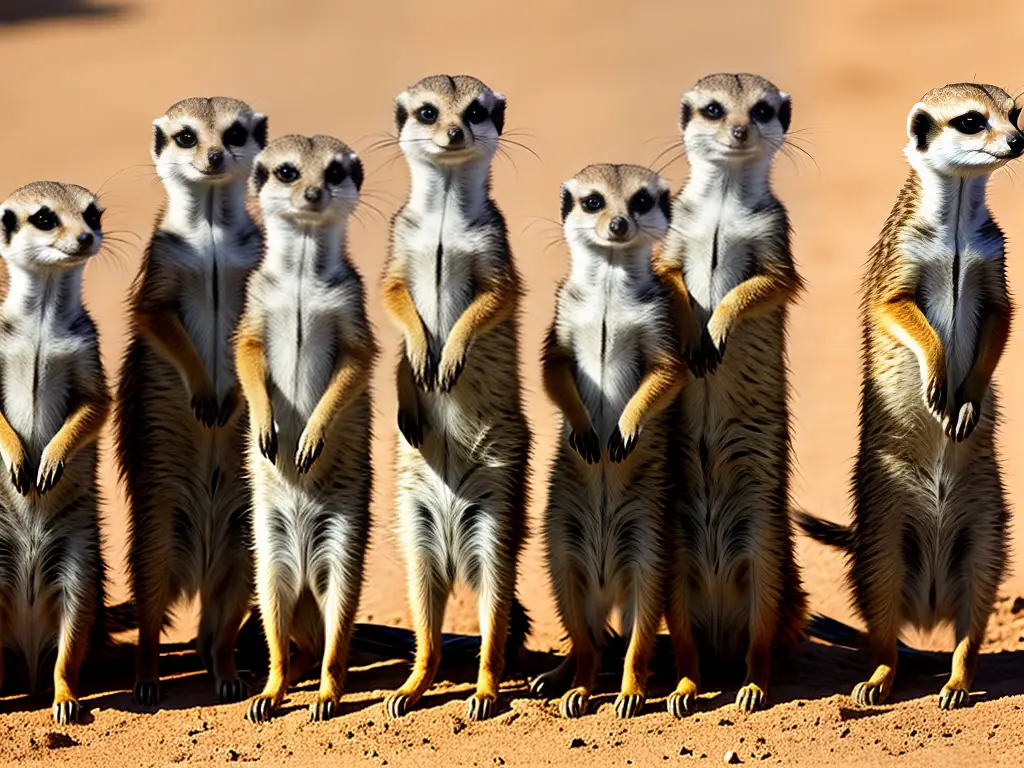
Meerkats’ Diet and Hunting
One interesting aspect of meerkats is their omnivorous diet, which means they consume a wide variety of food, ranging from insects to fruits and roots. They primarily feast on insects such as beetles, crickets, spiders, and scorpions, but they also eat lizards, small rodents, and other edible sources. This diverse diet contributes to their adaptability and resilience, factors that allow them to enjoy a healthy life expectancy despite the harsh conditions of their environment.
Meerkats are excellent and skilled hunters. They have a cooperative hunting system, where they work in groups to find food. Meerkats take turns as sentinels, standing on their two hind legs and keeping a lookout for predators or other danger while the others forage for food. This team effort helps keep the meerkats safe and increases their chances of finding food.
When meerkats hunt, they use their sharp sense of smell and keen vision to locate their prey. They then use their long, sharp claws to dig into the ground and uncover insects hiding below the surface. The meerkats’ ability to quickly adapt to new environments and their diverse diet has helped them survive, and their lifespan is generally around 12-14 years in the wild.
Meerkats are fascinating small mammals that live in groups called mobs or clans. Their life cycle begins when they are born, usually in litters of two to five pups. Meerkat babies are born hairless and with closed eyes, completely reliant on their mother’s care for the first few weeks of their lives.

Meerkats’ Life Cycle and Reproduction
The pups start to grow fur, open their eyes, and take their first steps around two to three weeks old. As they grow, the young meerkats learn from their family members how to dig burrows and search for food. A well-balanced and diverse diet is essential in keeping meerkats healthy and fit. This diet, rich in insects, fruits, and roots, provides them with the necessary nutrients and energy to thrive in their harsh and sometimes challenging environment. Additionally, their unique hunting strategy and cooperation make meerkats successful at finding and capturing prey, contributing to their overall health and longer life expectancy.
At around six weeks old, meerkat pups are introduced to solid foods by their families, who also teach them how to catch and eat insects. Meerkats are considered fully grown at about one year old, although they continue to gain weight until they are around two years old. At this point, meerkats are considered adults and can contribute to the mob’s survival by hunting, digging, and looking after younger siblings.
Meerkats have a unique mating system, with the dominant female in the group producing the majority of the offspring. She is usually the only one allowed to breed, and she mates with the dominant male or other males from different groups. Meerkat females have a gestation period of about 11 weeks and give birth in the safety of the burrow. The other adult meerkats in the mob help with raising the pups, teaching them important skills and protecting them from danger.
Meerkats are small animals that live in groups called mobs or clans, and they are commonly found in the grasslands, deserts, and savannas of southern Africa. Raising meerkat pups is a group effort, with everyone in the mob caring for and feeding the little ones. This cooperative behavior makes it easier for the dominant female to produce more offspring and ensures the survival of the group.
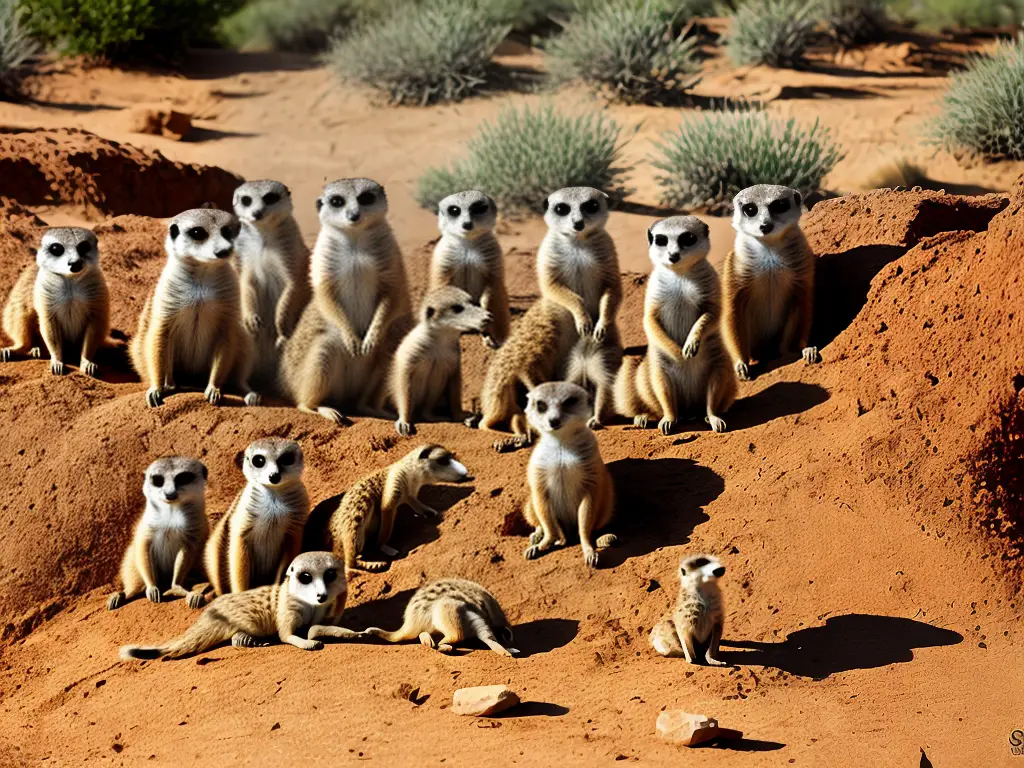
Predators and Threats to Meerkats
In the wild, meerkats face many predators and threats that can affect their life expectancy, which is usually around 6-7 years. However, their strong social bonds and cooperation give them a better chance of surviving, and some meerkats can even live up to 12-14 years. In captivity, where they have fewer threats and more resources, meerkats can live even longer, with life expectancies of 12 to 14 years or more.
One of the biggest threats to meerkats is predatory animals. Some of their main predators are birds of prey, such as eagles and falcons. These birds can quickly swoop down and snatch a meerkat off the ground. Another major predator is the mongoose, who shares a similar habitat and hunts for the same food as meerkats. Snake species such as the Cape Cobra also pose a threat to meerkats, especially their young ones, as they can easily be caught by these skilled predators.
Human intervention also affects meerkats’ life expectancy. The expansion of human settlements, agriculture, and infrastructure has led to a loss of habitat for these animals. As humans move closer to meerkats’ homes, they also bring domestic animals such as cats and dogs, which can prey on meerkats. Furthermore, humans may accidentally kill meerkats while driving through their territories, or by using harmful pesticides that poison their food sources.
Meerkats are small, social animals that live in the grasslands and savannahs of southern Africa. These curious creatures are known for their tight-knit family groups and cooperative behavior. To protect themselves from predators, meerkats have developed a system of sentries. These sentries keep watch for danger while the rest of the mob forages for food.
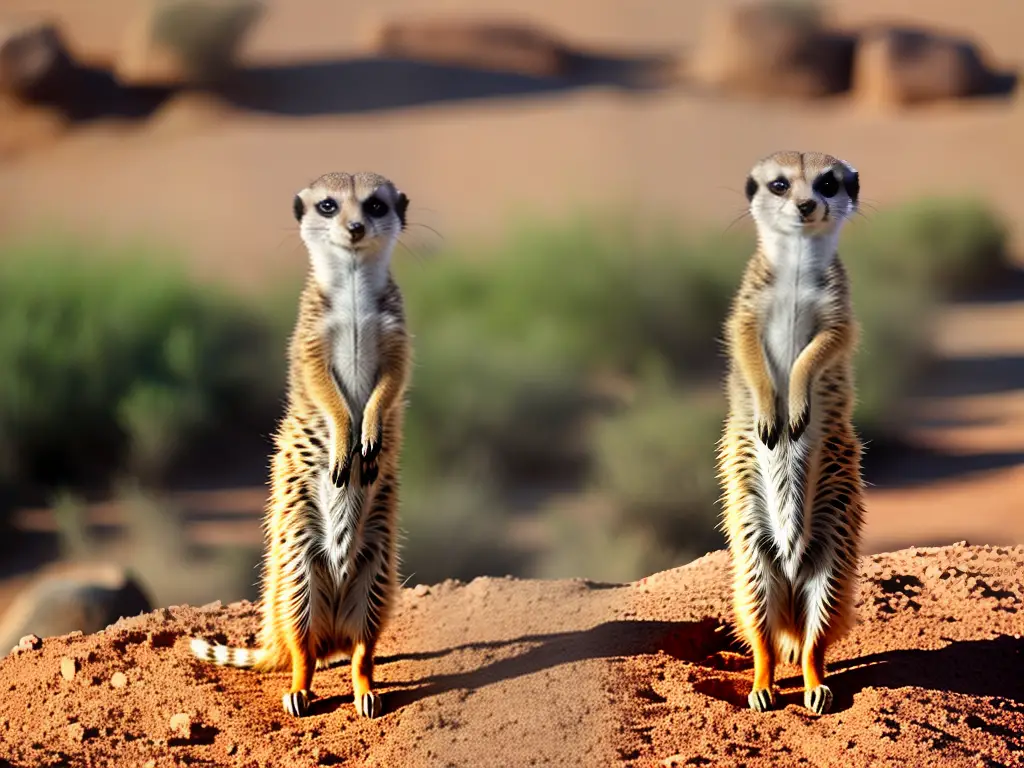
Conservation Efforts for Meerkats
If a sentry spots a threat, they will let out a high-pitched alarm call, warning their fellow meerkats to take cover or run for safety. This cooperative behavior helps them avoid predation and increases their chances of survival in the wild. In recent years, efforts have been made to protect these fascinating creatures and their habitats, ensuring their life expectancy increases.
One of the significant threats to meerkats is the loss of their habitat due to agriculture, human development, and mining. Conservation organizations have been working to create protected areas and nature reserves where meerkats can live without the threat of human encroachment. This helps to maintain their natural habitat and keep the population thriving.
Another crucial aspect of meerkat conservation is raising public awareness about these animals and their unique behaviors. Educating people about the importance of meerkats in the ecosystem can help to foster a better understanding of their role and why it is essential to protect their habitat. This could include teaching people how to live alongside meerkats and reduce any negative impacts on their environment.
Scientific research plays a vital role in understanding meerkats and ensuring their ongoing conservation. By studying their behavior, diet, and life expectancy, researchers can gather valuable information that helps develop strategies for managing and preserving meerkat populations. This ultimately benefits both the meerkats themselves and the ecosystems they inhabit.
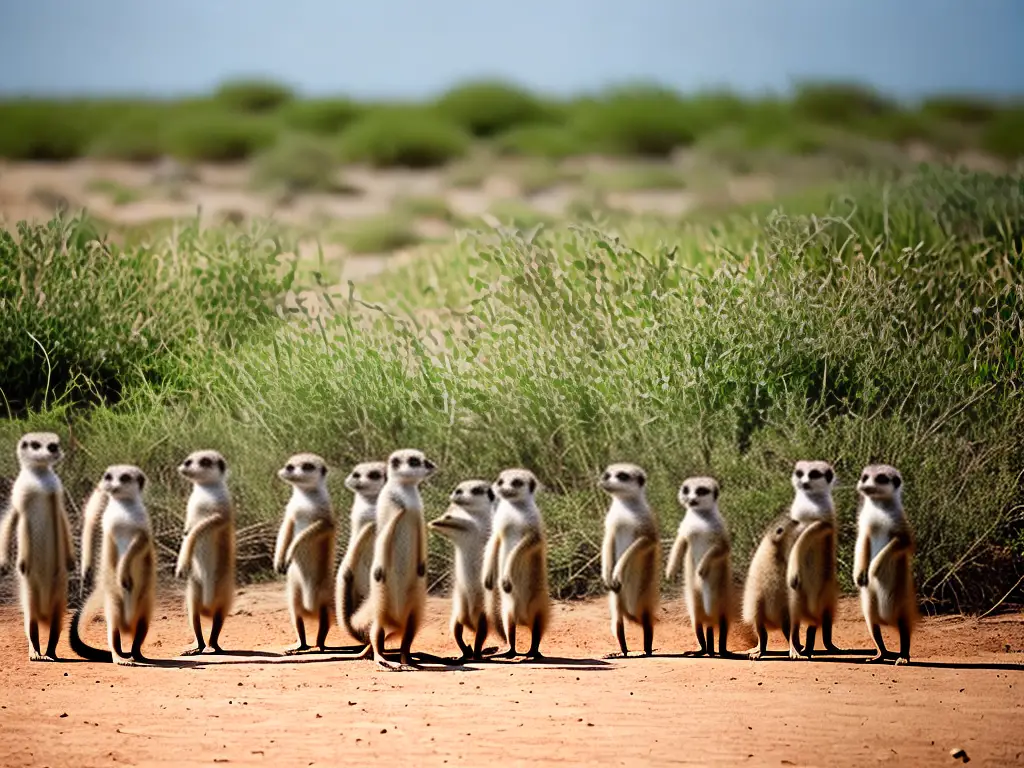
Meerkats’ Life Expectancy: Documentaries and Resources
A great way to learn about these small, social mammals native to southern Africa is by watching documentaries and reading reputable resources. Some interesting documentaries include ‘Meerkat Manor’ and the BBC’s ‘Planet Earth’ series, which feature meerkats. Through these sources, you can discover fascinating details about their lives, such as their life expectancy. Meerkats typically live for around 12 to 14 years in captivity, but usually only 6 to 8 years in the wild.
Another excellent source for understanding meerkats’ life is National Geographic. This renowned organization offers articles, videos, and photographs that capture the essence of meerkats’ lives. These resources provide detailed information about meerkats’ habitat, diet, social structure, and other fascinating aspects of their existence, such as how they work together to protect their territory from predators and look after their young.
Zoos and wildlife parks are also valuable resources for learning about meerkats. By visiting such institutions, you can see meerkats up close and personal, observe their behavior, and even ask questions to experts like zookeepers or wildlife conservationists. They can provide insights about the factors affecting the meerkats’ life expectancy, such as diseases, predation, and environmental changes.
Finally, don’t forget that books and scientific articles can help you expand your knowledge about meerkats. Visit your local library or search online for books and articles focusing on meerkats or other African wildlife. You’ll discover numerous interesting facts, not just about their life expectancy but also about their unique behavior, remarkable adaptation to harsh environments, and their role in their ecosystem.
